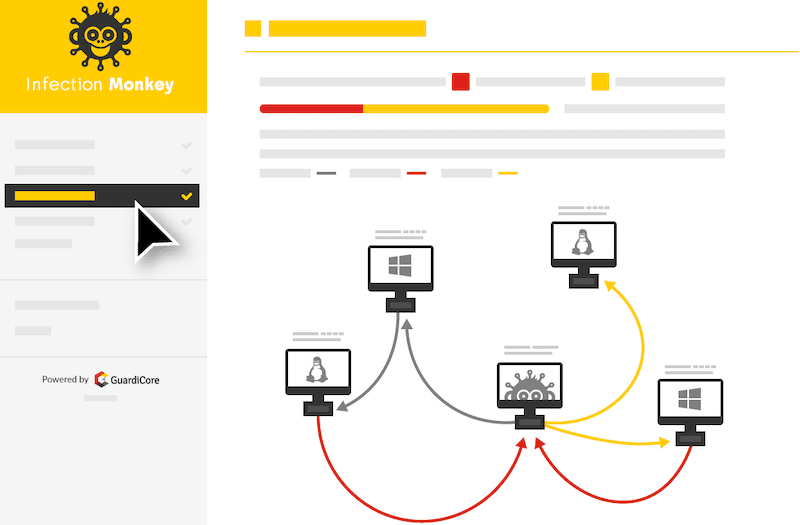One of the many news we hear in the current digital era is a cyber attack. It disturbs the business, damages the reputation, and panics end users. How do you ensure your network infrastructure is capable of mitigating cyber attacks?
Those days are gone where you rely on annual or quarterly penetration test results. In the current era, you need an automated breach attack simulation (BAS), continuous assets scanning, and, of course, protection. Thanks to the following tools, which let you simulate the real attack against your data center so you can review the results and take action. The best part is some of the tools that allow you to automate the action. Ready to prepare for the worse?
Infection Monkey
Are you running your application in the Cloud? Use Infection Monkey to test your infrastructure running on Google Cloud, AWS, Azure, or premises. Infection Monkey is an open-source tool that can be installed on Windows, Debian, and Docker.
You can run an automatic attack simulation for credential theft, misconfiguration, compromised assets, etc. Some of the worth mentioning features.
Non-intrusive attack simulation, so it doesn’t impact your network operations. Comprehensive audit report with an actionable recommendation to harden the web servers or other infrastructure Low CPU and Memory footprint Visualize network and attacker map
If you are a CISO or from the security team, then you will love the report. It is FREE, so give it a try today.
NeSSi2
NeSSi2 is an open-source, powered by JIAC framework. NeSSi stands for Network Security Simulator, so you can guess what it does. It focuses mainly to test intrusion detection algorithms, network analysis, profile-based automated attacks, etc.
It requires Java SE 7 and MySQL to set up and runs.
CALDERA
An adversary emulation tool. CALDERA supports only the Windows Domain network.
It leverages the ATT&CK model to test and replicate the behavior. Alternatively, you may also try Metta by Uber.
Foreseeti
securiCAD by foreseeti lets you virtually attack your infrastructure to assess and manage the risk exposure. It works in three simple concepts.
Create a model – add what all (server, router, firewall, services, etc.) you want to test Simulate an attack – to find out if and when your system breaks Risk report – based on simulation data, the actionable report will be generated which you can implement to lower the overall risk
securiCAD is an enterprise-ready solution and got a community edition with limited features. Worth giving a try to see how it works.
AttackIQ
AttackIQ is one of the popular security validation scalable platforms to strengthen your data center security. It is an offensive-defensive system to help security operation engineers exercise, red team capabilities. The platform is integrated with a vital framework – MITRE ATT&CK. Some of the other features are.
Powered by AttackIQ research team and industry security leader Customize the attack scenario to mimic the real-world threats Automate the attacks and receive continuous security status report Lightweight agents Works on a primary operating system and integrate well with existing infrastructure
They offer two weeks FREE trial to try their platform. Give a try to see how well is your infrastructure posture.
SCYTHE
Know where your organization stands in security risk exposure. Scythe platform got a powerful and easy-to-use workflow to create and launch a real-world cyber threat campaign. With the help of data, you can analyze your security endpoints in real-time. Scythe is offered as a SaaS model or on-premises. Whether you are a red, blue, or purple team – it fits all. If you are interested in learning red team activity, then check out this online course.
XM Cyber
XM Cyber offers automated advanced persistent threat (APT) simulation solution. Stay ahead of the attacker.
You can select the target to run and setup on-going attacks and receive a prioritized remediation report—some highlights about the tool.
Customize the attack scenario based on needs Visualize attack path Up-to-date attack methods Best practices and policies recommendation
Randori
Randori is a reliable, automated red team cyber-attack platform for testing security systems’ effectiveness in preventing attacks. It has the capacity to generate and launches the real exploits and attacks the same way an attacker would do but in a safe way. The platform has benefits such as;
Assessing entire security solutions and identifying weaknesses. Provide insight into how an attack would see the organization’s assets. Allows teams to simulate real attacks, in a safe way, towards the organization’s IT systems. Provides real-time attack target analysis It allows you to test defenses, identify weaknesses, and stop assuming that you are secure.
Picus
Picus is a security and risk management solution that enables you to continuously assess, measure, and mitigate vulnerabilities, hence enable your organization to stay ahead of the cybercriminals. With an easy to configure and use dashboard, the Picus security breach and attack simulation platform provides real attacks to test your defenses and determine if they are offering adequate protection.
It has benefits such as;
Extensive threat database and corresponding protection measures Real-time identification of weak as well as strong security layers, – allowing teams to quickly identify and address security gaps. Fine-tune and maximize the complex security technologies Enables quick identification of vulnerabilities as well as suggesting the optimum mitigation measures to reduce risks. Provides Real-time visibility into an organization’s security attacks preparedness and ability to address weaknesses.
Conclusion Managing an organization’s IT security risk is challenging, and I hope the above tools help you implement a world-class control to lower the risk exposure. Most of the listed tools offer a free trial, so the best thing to do is give a try to see how they work and go for the one you like.












